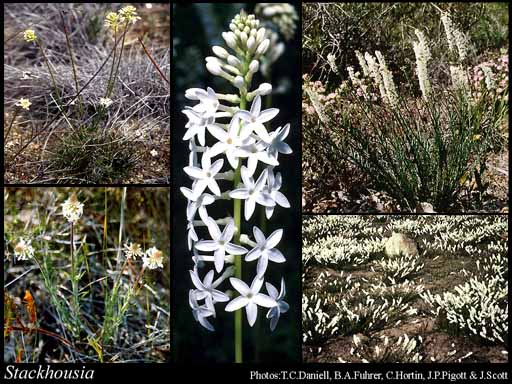- Reference
- Trans.Linn.Soc.London,Bot. 4:218 (1798)
- Name Status
- Current

Scientific Description
Common name. Candles. Family Stackhousiaceae.
Habit and leaf form. Herbs. ‘Normal’ plants, or switch-plants. Leaves well developed, or much reduced (scale-like, rarely). Plants succulent to non-succulent, or non-succulent. Annual, or perennial. Young stems ribbed. Stem internodes solid. Perennials rhizomatous. Mesophytic, or xerophytic. Leaves alternate; spiral; ‘herbaceous’, or leathery, or fleshy, or membranous; sessile; non-sheathing; simple; epulvinate. Leaf blades entire; linear, or lanceolate, or oblanceolate; one-veined, or pinnately veined. Leaves sometimes inconspicuously with stipules. Stipules interpetiolar; minute, terete; caducous (sometimes), or persistent. Leaf blade margins entire. Leaf anatomy. Hairs present, or absent. Extra-floral nectaries absent.
Reproductive type, pollination. Fertile flowers hermaphrodite. Unisexual flowers absent. Plants hermaphrodite.
Inflorescence and flower features. Flowers solitary, or aggregated in ‘inflorescences’; in spikes (spike-like), or in umbels (umbelliform). The terminal inflorescence unit cymose, or racemose. Inflorescences terminal; several to many-flowered. Flowers pedicellate (shortly); bracteate (narrow, 1 subtends each flower); bracteolate (2 subtend each flower); small, or medium-sized; fragrant (Stackhousia), or odourless; regular to somewhat irregular. The floral asymmetry involving the androecium. Flowers 5 merous; cyclic; tetracyclic. Free hypanthium present; campanulate (or cup-shaped); persistent in fruit. Hypogynous disk present (lining the calyx tube). Perianth with distinct calyx and corolla; 10; 2 -whorled; isomerous. Calyx present; 5; 1 -whorled; polysepalous (A), or gamosepalous (connate towards the base); blunt-lobed; imbricate; regular, or unequal but not bilabiate. Corolla present; 5; 1 -whorled; polypetalous, or gamopetalous; imbricate; tubular; unequal but not bilabiate, or regular; white, or yellow, or purple. Petals rhombic, or ovate (or narrowly ovate). Corolla lobes rhombic, or ovate. Petals clawed (the claws free, even when gamopetalous above). Androecial members definite in number. Androecium 5. Androecial members free of the perianth; markedly unequal (usually three long, two short); free of one another; 1 -whorled. Androecium exclusively of fertile stamens. Stamens 5; isomerous with the perianth; oppositisepalous (on the margins of the disc). Anthers dehiscing via longitudinal slits; tetrasporangiate; unappendaged. Gynoecium (2–)3(–5) carpelled. The pistil 2–5 celled. Carpels reduced in number relative to the perianth to isomerous with the perianth. Gynoecium syncarpous; synovarious to synstylovarious; superior. Ovary plurilocular; 2–5 locular; sessile. Gynoecium stylate. Styles 1, or 2–5; free, or partially joined; attenuate from the ovary, or from a depression at the top of the ovary; apical. Stigmas 1; 2–5 - lobed (spreading). Placentation axile to basal. Ovules 1 per locule; ascending; apotropous; with ventral raphe; anatropous.
Fruit and seed features. Fruit non-fleshy; not an aggregate; a schizocarp. Mericarps comprising nutlets, or samaroid. Fruit 2–5 celled; 2–5 seeded (1 per coccus). Seeds endospermic. Endosperm oily. Cotyledons 2. Embryo straight.
Etymology. After John Stackhouse (1742–1819), English botanist who studied seaweeds.